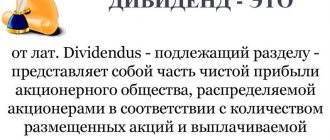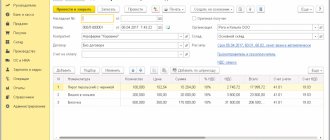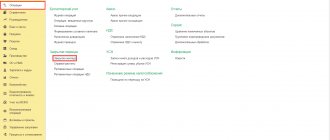Account 84 “Retained earnings (uncovered loss)”
The result of a company's commercial activities can be either profit (if income exceeds expenses) or loss (in the opposite situation).
To reflect and accumulate data on financial results in accounting, it is customary to use account 84 “Retained earnings (uncovered loss).” This account contains information about the net total amount accumulated by the company at the end of the relevant reporting period. In other words, account 84 reflects not only the net profit (NP) generated in the current period, but along with it also the retained earnings of previous years (NP) or uncovered loss (UN).
ATTENTION! The state of emergency for the past year is shown on line 2400 of the financial results report (hereinafter referred to as the report). The balance of NP or NU minus dividends can be seen in line 1370 of the balance sheet.
In the tax guide from ConsultantPlus you will find step-by-step instructions for filling out line 1370 of the balance sheet. If you do not have access to the K+ system, get a trial online access for free.
How the company’s PE is calculated, see the article “How to calculate net profit (calculation formula)?” .
The amount of NI for previous years is indicated by the credit turnover of account 84. In circumstances where the company received NI in the current year, the company compensates for it from retained earnings remaining from previous years. If the company did not have NP or NU in previous years, the financial result indicated in line 1370 of the balance sheet (taking into account the payment of dividends) will be equal to the PE from the report.
Read about the nuances of reflecting retained earnings in the balance sheet in the material “Retained earnings in the balance sheet (nuances).”
Accounting entries involving account 84
In accordance with the current Chart of Accounts, which was approved by Order of the Ministry of Finance dated October 31, 2000 No. 94n, accounting account 84 can be used in the following correspondence:
- Dt 84 Kt 51-52, 55, 70, 75, 79-80, 82-84, 99;
- Dt 73, 75, 79-80, 82-84, 99 Kt 84.
When reforming the balance sheet at the end of December of the reporting year, a posting must be made involving accounts 84 and 99. If there is a profit - Dt 99 Kt 84, a loss - Dt 84 Kt 99. The direction of profit for the payment of dividends is displayed as follows: Dt 84 Kt 75, dividends to employees - Dt 84 Kt 70.
To learn how such profit is reflected in the balance sheet, read the article “Retained earnings in the balance sheet (nuances).”
The distribution of NRP among on-farm reserves and funds is displayed as follows:
- Dt 80 Kt 84 - reducing the size of the enterprise’s capital to the value of its net assets;
- Dt 84 Kt 80 - direction of the NRP to increase the capital;
- Dt 82 Kt 84 - covering losses from reserve capital;
- Dt 83 Kt 84 - covering losses through additional capital;
- Dt 75 Kt 84 - the company’s loss was repaid through contributions from its owners;
- Dt 84 Kt 83 - direction of NRP to increase additional capital;
- Dt 84 Kt 84 - internal movement of NRP across subaccounts (for example, creation of an accumulation fund, reserving funds for a planned acquisition).
You will find more entries for accounting for non-distributed income in the article “Accounting for retained earnings on account 84 (entries).”
Retained earnings: entries
Operations carried out on account 84 and necessary to account for retained earnings and uncovered losses are carried out at the end of the year. NP is reflected by credit turnover, and NU by debit turnover. In both cases - according to account 84 in correspondence with account 99. In the latter, by the way, the financial result is displayed throughout the year.
In this regard, we recall that the accountant must make closing entries with the following content at the end of each month:
| Dt | CT | Operation description |
| 90.9 | 99 | Profit from core activities is taken into account |
Or:
| 99 | 90.9 | The loss incurred from the main activity is taken into account |
Or:
| 91.9 | 99 | Profit received from other activities is taken into account |
Or:
| 99 | 91.9 | The loss arising from other activities is taken into account |
When the year ends and the balance sheet accounts are closed, the ending balance of account 99 should be transferred to the retained earnings account by posting:
| Dt | CT | Operation description |
| 99 | 84 | The company's emergency is taken into account |
Or
| 84 | 99 | The company's loss is taken into account |
As a result of postings at the beginning of the next year, account 99 should be reset to zero. This sequential closing of accounts with the writing off of retained earnings to account 84 and revealing the result is called balance sheet reformation.
Correspondent accounts of account 84
The main corresponding account, which determines the financial significance of account 84 at the end of the year, is account 99 “Profits and losses”. Its debit balance, demonstrating the unprofitability of the activity, is written off to zero at Kt84 , and the credit balance, indicating the profitability of the enterprise, at Dt84 .
Posting to account 84 is carried out once a year, after completion of other account transactions.
The remaining correspondent accounts depend on the purposes of profit distribution or the methods of covering losses provided for in the company documents:
- account 70 - when paying dividends to employees of the enterprise;
- account 75 – when paying dividends or collecting additional funds from the founders of the company;
- account 80 – when cash flows through the authorized capital;
- account 82 - when compensating for losses or directing profits to the reserve fund;
- account 83 – for correspondence with additional capital funds.
Disposal of retained earnings from previous years
The profit received by the company can be distributed exclusively by order of the owners of the company. This norm is provided for by the laws “On Limited Liability Companies” dated 02/08/1998 No. 14-FZ and “On Joint-Stock Companies” dated 12/26/1995 No. 208-FZ.
But there are also certain distribution frameworks that establish that when an NP is formed at the end of the year, the company is allowed to use it for the following purposes:
- issuance of dividends;
- repayment of previously incurred losses;
- to account 84 to accumulate profits for the purpose of its further use;
- formation of reserve capital;
- increase the authorized capital;
- other purposes established by laws No. 14-FZ and No. 208-FZ.
For example, the company's management has the right to reward employees from distributed profits. Find out how to correctly account for such payments in the material from ConsultantPlus. If you do not have access to the K+ system, get a trial online access for free.
The direction of NP for the above purposes is accompanied by the corresponding entries in accounting:
| This year's NP is aimed at: | Dt | CT |
| For accrual of dividends | 84 | 75 |
| Formation of reserve capital | 84 | 82 |
| Increase the authorized capital | 84 | 80 |
In circumstances where the company decides to use retained earnings in account 84 to compensate for losses from previous years, it is necessary to make a posting between internal subaccounts. In other words, do internal wiring.
When a company receives a loss at the end of the year, it is allowed to repay it from the following resources:
- reserve capital;
- NP of previous years;
- authorized capital (after changes in the charter);
- target funds belonging to the founders.
In this case, the following wiring is required:
| If the loss is covered by: | Dt | CT |
| Reserve capital | 82 | 84 |
| Founders' target funds | 75 | 84 |
| Authorized capital | 80 | 84 |
In addition, the company has the opportunity to significantly reduce the loss incurred in the current period due to retained earnings from previous years. In a company that decides to do this, the accountant will make an internal entry to account 84.
Characteristics of account 84
Account 84 “Retained earnings” is one of the most important financial accounts of any organization. It is to this account that the final entries from the account are written off. 99, depending on the result obtained for the reporting year - profit (income exceeds costs) or loss (costs exceed income). In addition, from the account 84 money is used to pay income to the founders - both employees of the enterprise and third parties.
84 accounting account allows you to obtain aggregate information about the amount of profit/loss after tax for all types of company activities that have not yet been distributed for various purposes. Analytical accounting is organized in order to monitor the performance of individual commercial areas. At the same time, you can divide the unused profit and the profit already spent on the development of the enterprise, and also see what part of the financial result was formed from the current year’s activities and what part relates to previous periods.
Results
Retained earnings are after-tax earnings that are not used for dividends paid to the founders of the company. The balance sheet reflects the IR for the entire period of the company’s activities.
IR represents a share of a company's equity capital.
It can be directed by order of the owners for the purposes provided for by laws No. 14-FZ and No. 208-FZ. You can find more complete information on the topic in ConsultantPlus. Free trial access to the system for 2 days.
Closing account 99 at the end of the year
At the end of the year, the balance sheet is reformed - all subaccounts to accounts 90, 91 and 99 are closed with internal entries. After this, the balance remains only on subaccount 99.01. This is the financial result of the reporting year; it is written off to account 84.
Reformation of the balance sheet is the final operation of the reporting year. As of January 1 of the following year, the balance in account 99 should be zero.
If at the end of the reporting year a profit is made (the account balance is 99 credits), the following entry is made:
Debit 99 Credit 84 - reflects the net profit of the reporting year.
If at the end of the reporting year a loss is received (account balance 99 is debit), the following entry is made:
Debit 84 Credit 99 - reflects the net (uncovered) loss of the reporting year.
Uncovered loss
To record losses incurred in the reporting year, a separate subaccount – 84/4 – can be created. If its value is not covered by the profits of previous periods, then the founders of the company make a decision to repay it from other sources, or leave it on the balance sheet. In this case, it becomes uncovered and is entered with a negative value in line 1370 of the balance sheet.
Sources for covering losses are various funds and reserves. Postings can be like this:
| Operation | D/t | K/t |
| Repayment of losses through: | ||
| – reserve fund | 82 | 84 |
| – additional capital | 83 | 84 |
| – authorized capital (reduction of the authorized capital to the amount of net assets is allowed) | 80 | 84 |
| – owner funds | 75 | 84 |
Reflection of the indicator of previous years
Retained earnings from previous years are reflected in account 84 in accordance with the above formula. In order to reflect on the balance sheet entries with account 84 for previous years, the accounting entries shown in the table below are used.
As a result of making all the necessary entries at the end of the reporting period, the enterprise’s balance sheet on account 84 displays the total result regarding retained earnings (uncovered loss) for the reporting and all previous periods using the cumulative (accumulative) method. Thus, it is always possible to analyze the activities of the enterprise, the results of which take into account the payment of all mandatory payments and dividends, based on the numerical value of this account.
Closing account 84 at the end of the year - postings
Monthly postings to the account. 84 are performed to write off the results of the enterprise’s activities. The accountant closes profit/loss like this:
- D 90.9 K 99 or D 99 K 90.9 – profit (or loss) from the main activity is reflected.
- D 99 K 84 – the state of emergency is written off (net profit). Accordingly, the credit 84 of the account shows a profit, and the debit (entry D 84 K 99) shows a loss.
At the end of the year, the balance sheet is reformed, meaning the corresponding accounts are consistently reset to zero. How is account 84 formed when disposing of funds? Postings are made depending on the purpose of the write-off:
- D 84 K 75 – money was allocated to accrue annual dividends.
- D 84 K 80 – to increase the authorized capital.
- D 84 K 82 – for the formation of reserve capital.
- D 84.3 K 84.2 – part of the accumulated loss is covered.




